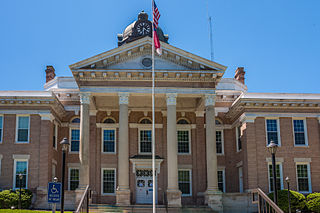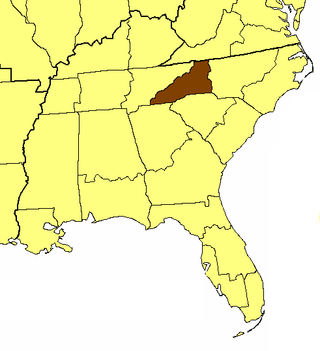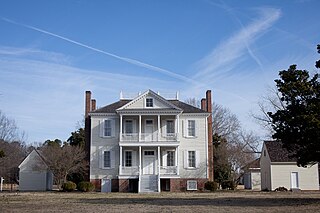
Halifax County is a county located in the U.S. state of North Carolina. As of the 2020 census, the population was 48,622. Its county seat is Halifax.

Roxobel is a town in northwestern Bertie County, North Carolina, United States. It dates to 1724 and was originally known as Cotten's Cross Roads. After several name changes, it has remained Roxobel since 1849. The population was 240 at the 2010 census.

Roanoke Rapids is a city in Halifax County, North Carolina, United States. The population was 15,754 at the 2010 census. It is the principal city of the Roanoke Rapids Micropolitan Statistical Area, and is also an anchor city of the Rocky Mount-Wilson-Roanoke Rapids CSA, with a total population of 297,726 as of 2018.

Valle Crucis in an unincorporated community and census-designated place located in Watauga County, North Carolina, United States. The name of the town is Latin for "Vale of the Cross," a reference to a valley in the area where three streams converge to form a shape similar to an archbishop's cross. The community is located along NC 194, between the towns of Banner Elk and Boone.
William West Skiles (1807–1862) was an American missionary, a Deacon in the Episcopal Church, and a teacher and community leader. He helped to found the community of Valle Crucis, North Carolina and to establish the church and missionary center there.
The Alice Freeman Palmer Memorial Institute, better known as Palmer Memorial Institute, was a school for upper-class African Americans. It was founded in 1902 by Dr. Charlotte Hawkins Brown at Sedalia, North Carolina near Greensboro. The institute was named after Alice Freeman Palmer, former president of Wellesley College and benefactor of Dr. Brown.

Roanoke Island Festival Park is a North Carolina state historic site located at the end of NC 400 in Manteo, North Carolina on Roanoke Island. The park includes a recreated 16th-century sailing ship, living history demonstrators, a museum, and a variety of performing and visual arts. Admission includes the main attractions and is valid for two days.

The Episcopal Diocese of Western North Carolina is a diocese in the Episcopal Church. It consists of 28 counties in western North Carolina and its episcopal see is in Asheville, North Carolina, seated at the Cathedral of All Souls. The first recorded worship from the Book of Common Prayer west of the Catawba River was in 1786. Valle Crucis, where one of the two conference centers is located, began as a missionary outpost in 1842. In 1894, a resolution was adopted in the Convention of the Diocese of North Carolina that the Western part of the state be set aside and offered to the General Church as a Missionary District. The following year, in November 1895, the first Convention of the District of Asheville was held at Trinity Church in Asheville. In 1922, after all the requirements had been fulfilled, a petition from the Jurisdiction of Asheville to become the Diocese of Western North Carolina was presented at the General Convention of The Episcopal Church. It was accepted on September 12, 1922.

Rockford is an unincorporated community and former town in southern Surry County, North Carolina, United States.

The Joel Lane House, also known as Wakefield, was built in 1769 and is now a restored historic home and museum in Raleigh, North Carolina. It is the oldest dwelling in Wake County and contains collections of 18th century artifacts and period furnishings. The museum grounds include a detached middle-class home built circa 1790, a formal city garden, and a period herb garden. The house is named after Joel Lane, the "Father of Raleigh" and "Father of Wake County."

S&W Cafeteria was a Charlotte, North Carolina-based chain of cafeteria-style restaurants. The chain specialized in low-cost, Southern-style food. Branches were located in the Southeastern United States from Washington, D.C. to Atlanta, Georgia.

Hope Plantation, built in 1803, is an early house built in the Palladian mode of the federal style, located on the Carolina Coastal Plain, near Windsor, North Carolina, in the United States. The plantation house was built by David Stone, a member of the coastal Carolina planter class, later Governor of North Carolina and a United States senator. One of the finest examples of Palladian design built in timber, the manor house is slightly modified by neo-classical elements. The facade has five bays and a pedimented double portico with the original Chinese Chippendale balustrade. Crowning the house is a widow's walk with matching railing. The interior of the house displays a height and grandeur rare in the region, and is furnished with a unique collection of period furniture, art and artifacts.

The James Iredell House is a historic home located at Edenton, Chowan County, North Carolina. The original section was built 1800, and expanded to its present configuration about 1827. It is a two-story, L-shaped frame dwelling with Georgian and Federal style design elements. It was the home of James Iredell, an ardent patriot and Justice of the Supreme Court.

The Roanoke River Lighthouse is a historic, decommissioned lighthouse, located on the waterfront of Edenton, North Carolina. The lighthouse once stood in Albemarle Sound at the mouth of the Roanoke River, across the Sound from its current location. The only surviving screw-pile lighthouse in the state, it has since been moved twice, and a replica of a predecessor light has been erected at a fourth location.

Valle Crucis Episcopal Mission, also known as Valle Crucis Conference Center, is a historic Episcopal mission church complex and national historic district located near Valle Crucis, Watauga County, North Carolina. The Gothic Revival style, gable-front stone Church of the Holy Cross was built about 1924. Other contributing resources are the church cemetery with the earliest burial dated to 1808, Auchmutv Hall dormitory (1910-1911), The Annex, "The Farm House" (1915), Former Dairy Barn, Former Apple Barn, The Mission House (1896), the Power Dam (1903-1930), the Valley / Field, and the Apple Orchard. The Valle Crucis Episcopal Mission was established by the Episcopal Church in 1844-1845.
Hobart Brown Upjohn (1876–1949) was an American architect, best known for designing a number of ecclesiastical and educational structures in New York and in North Carolina. He also designed a number of significant private homes. His firm produced a total of about 150 projects, a third of which were in North Carolina.

North Carolina Highway 194 (NC 194) is a primary state highway in the U.S. state of North Carolina. Entirely in the High Country, it runs from US 19E, in Ingalls, to the Virginia state line, near Helton.

Halifax Historic District is a national historic district located at Halifax, Halifax County, North Carolina, US that was listed on the National Register of Historic Places in 1970. It includes several buildings that are individually listed on the National Register. Halifax was the site of the signing of the Halifax Resolves on April 12, 1776, a set of resolutions of the North Carolina Provincial Congress which led to the United States Declaration of Independence gaining the support of North Carolina's delegates to the Second Continental Congress in that year.

The Mast Farm is a historic farm located near Valle Crucis, Watauga County, North Carolina and is now the Mast Farm Inn. In the late 1700s, Joseph Mast walked from Pennsylvania and settled on much of the land that is now Valle Crucis. Around 1810, his son David built the two-room log cabin which now sits facing the main house at the Mast Farm. David's son Andrew began building the main house around 1880. Andrew's son, D. Finley Mast, completed it in 1896. A photo of the house in the early 1900s shows a sign stating simply, "BROOKSHIDE FARM, D. FINLEY MAST, ONE HALF MILE TO POST OFFICE." Originally, the main house consisted of only the part closest to the road – three stories high, with two rooms on each floor. Like most large homes with open flames for cooking, it had a detached kitchen. The main house is a two-story frame dwelling with a gable roof. In the early 1900s, Finley and his wife, Josephine, began to make additions to the house and to operate it as an inn. Over a period of about twenty-five years, five different symmetrical additions were completed, ultimately comprising thirteen bedrooms – and one bathroom. Other contributing buildings are an eight-sided gazebo (1890), wash house, spring house, meat house, log woodhouse, apple house (1905), weaving house, blacksmith shop, and gambrel roofed barn. The weaving house served as the original farm house.

Valle Crucis Historic District is a national historic district located at Valle Crucis, Watauga County, North Carolina. The district encompasses 50 contributing buildings, 1 contributing site, and 7 contributing structures in the central business district and surrounding residential sections of Valle Crucis. It developed between about 1812 and 1954, and includes notable examples of Gothic Revival, Bungalow / American Craftsman, and Colonial Revival style architecture. Located in the district are the separately listed Mast General Store, Mast Farm, and Valle Crucis Episcopal Mission. Other notable contributing buildings are the Baird Farm, Lucy Mast Olsen House (1936-1940), Taylor tobacco barn, Farthing Store (1909), Valle Crucis Bank (1914), Hard Taylor House, and C. D. "Squire" Taylor House (1911).























